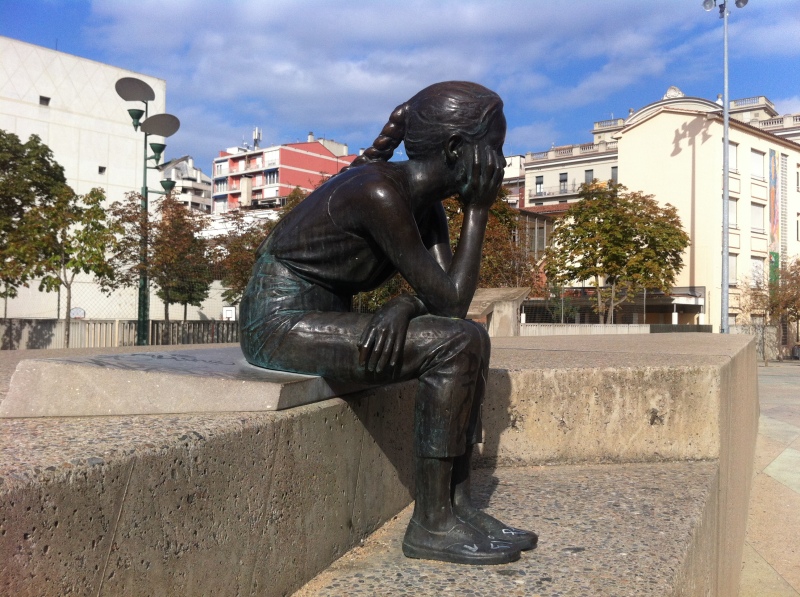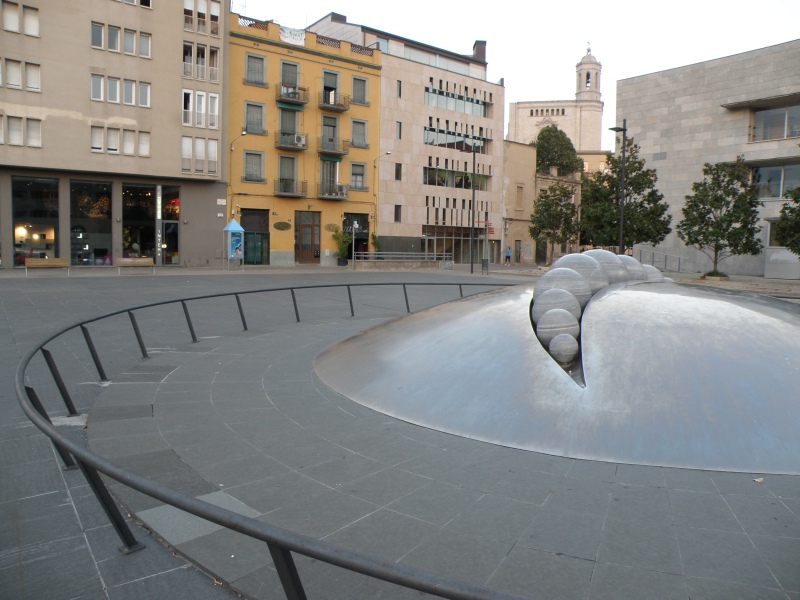Promoting the benefits from the embracing of Cultural Heritage & Ecology, these posts feature in En & Gr thoroughly edited and researched, illustrated by my photos. Enjoy the journey!
2012 © Copyright. All rights reserved
Night in the old city of Girona, city of the four rivers, with the musical names of Ter, Onyar, Galligants and Guell. I sit in a bar near the Cathedral, listening to a Scottish ballad; the rough traveler’s voice belongs to a man in his early twenties. I stepped into the bar attracted by the coarse voice, the sound and the contradiction. It fits my mood, it fits the city.
Girona is a small city of 100.000 people with the charm of an open crossroad from the influence of the cultures and nations that have passed and left their traces behind.
Girona is one of the four provinces of Catalonia; in Catalan Catalunya, in Spanish Cataluña. Today Catalonia is populated with approximately 7,5 million people; Barcelona is the capital and biggest city. It was colonized by the Ancient Greeks, who ruled the area with the Carthaginians until conquered by the Romans. After the fall of the Western Roman Empire the Visigoths conquered the area and ruled for two and a half centuries. In the 8th century it came under the Moorish, until Emperor Charlemagne conquered it.
theatrical houses over the river Onyar
It is the landmark of Girona. Widely painted and photographed ‘the houses hanging over the river Onyar’ present a playful, ever-changing sight; it alters every minute by the light conditions, their reflection mirrors on the water. From the opposite bank you can watch the houses and their accessories participating in the continuous gestures of the people who live and work here, as they open and close windows and blinds, as they display and collect their laundry, as they smoke at the balconies in the afternoon light. And when it is getting dark, you may take a glimpse of couples embracing against the lit background of an apartment. After walking up and down the banks and crossing the bridges, you may get the impression of belonging in this theatrical setting; like taking an active part in an improvisation where one’s gestures are seen and reproduced in a long repetitive sequence that unravels along the river, through the centuries.
This theatrical atmosphere is further cultivated by the colorful facades of these river houses. Each is painted to follow a pattern, according to the Color Project, made and directed by the Catalan artist Enric Ansesa in the 1980’s. According to Wikipedia, James J. Faixó and the architects Josep Fuses and Joan Maria Viader were involved in the project too.
cultural heritage in the Old town of Girona
The city walls of the old town were an important military construction built in Roman times. Parts were demolished at the end of the 19th century to allow for the expansion of the city. In recent years, the missing parts on the eastern side of the city have been reconstructed. You can enjoy a walk along the top of the city walls, the Passeig de la Muralla.
Medieval Girona is linked to the Jewish community that lived in the city between the 9th and the 15th centuries. They played an important role in the social and economic development with a golden age between the 12th and the first half of the 14th century. Most traces of Girona’s rich Jewish history were wiped out when the Catholic Kings expelled all the Jews from Catalonia. Today, the Jewish quarter is one of the best preserved in Europe and the Museum of Jewish History (Museu del Jueus) is a testimony to the community that lived here until 1492.
drawing my map of Girona
I arrived by bus from Barcelona airport one sunny Thursday afternoon of late September. After checking in the hotel I took a walk in the left bank of the Mercadal neighborhood with Plaça de la Independència and the Museu del Cinema. I crossed over the red Pont de les Peixateries Velies, of 1877, by architect Manuel Almeda and constructor Gustave Eiffel, the most famous of the 11 bridges of Girona. Reaching the traditionally commercial right bank, I strolled up to the Cathedral, famous for the widest Gothic nave in the world; finally, I was lost in the maze of cobbled streets of the old Jewish quarter El Call.
The traffic is restricted in the old quarter and the streets are ideal for walking and cycling with an abundance of shops, cafes, gelaterias, bakeries, pastry shops, restaurants offering a delicious variety of tapas, cheese, wine, deserts.
The city is safe, friendly, palpitating with a youthful rhythm.The narrow medieval streets are buzzing with vivacity all hours of day and night, with tourists, cyclists, and crowds of students from the University of Girona which add gracefully 15.000 to a population speaking both Catalan and Spanish.
Girona is favored by cyclists who come to do their training here. Well-known professional cyclists such as Lance Armstrong came to live in the city. The city has a roller hockey team, one of the most important in Spain.
the stamp of Girona could be a wheel
Coming from Greece, from Athens, a place with an increasing demographic problem, it is impressive how many baby strollers, toddlers and children on bicycles roll around.
If I were to take the imprint of Girona it would be a wheel of a roller, or a bicycle. Round as a ball of ice cream tasting strawberry.
The moon is filling up, a bit blurred and hazy from the humidity. Tonight is Sunday, my fourth night here. Tomorrow I will leave for my road trip to Costa Brava.
In the square of Saint Feliu is the replica column of La Lleona, the Lioness. The rite of touching or kissing the bottom of the lioness is part of the urban mythology of the city and derives from the past. It became a sort of baptism to newcomers to Girona and for the inhabitants of Girona a guarantee of a happy return to the city, after having been away. As a visitor a kiss guarantees that you will return one day. The ritual is accompanied by its saying: ‘You can’t be a resident of Girona until you’ve kissed the bottom of the lioness’.
I leave Girona with the promise to return and the city’s motto on my lips: Girona m’ enamora, Girona inspires me with love.
Special thanks to Costa Brava Pirineu de Girona and the Sponsors of TBEX’ 12 for their exquisite hospitality. It was my first time to attend a TBEX Conference of Travel Bloggers and I found it a resourceful and enjoyable experience.
2012 © Copyright. All rights reserved
If you like this post you may also want to check http://to.ly/gP34
For more info http://www.costabrava.org/














Leave a comment